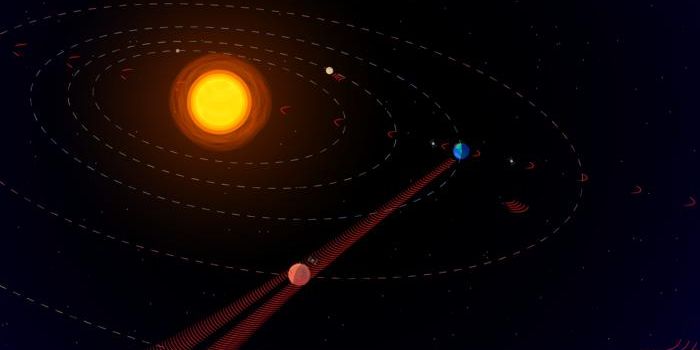December 2023 Celestial Events
Labroots recently shared key celestial events for November 2023 which offered skywatchers an opportunity to witness 16 days of events that included numerous meteor showers, comets, and planetary encounters. Now, Labroots wishes to share with you 22 days of celestial events for December 2023 that will ensure astronomy fans will not be disappointed. Each event is labeled in all caps for the type of event (e.g., MOON, PLANET, COMET, etc.) to provide skywatchers additional excitement to catch these incredible events!
December 1 (MOON and STAR): The Earth’s Moon will pass between 1-2 degrees from the star Pollux, which is located just under 34 light-years from Earth and resides within the constellation Gemini.
December 2 (MOON, STARS, and METEOR SHOWER): The Earth’s Moon will pass between 3-4 degrees from the Beehive Cluster, which is an open cluster of stars located approximately 577 light-years from Earth and is approximately 15 light-years in diameter. Additionally, the Phoenicids meteor shower will be at its peak with a variable number of observable meteors per hour.
December 4 (PLANET): The planet Mercury will be at its greatest elongation, meaning it will be orbiting at its farthest from the Sun, which provides the best time to observe Mercury since it will be outside the Sun’s glare.
December 5 (MOON): Last Quarter Moon. When observing from the Earth, skywatchers will see the entire left side of the Moon being lit while the right side is shrouded in complete darkness.
December 6 (METEOR SHOWER and PLANET): The Phi Cassiopeiids meteor shower will be at its peak with a variable number of observable meteors per hour. Additionally, the planet Neptune will end its retrograde motion, meaning it stops appearing to move backwards in the sky and begin the move in the opposite direction.
December 7 (METEOR SHOWER): The Puppid-Velids meteor shower will be at its peak with approximately 10 observable meteors per hour.
December 8 (MOON and STAR): The Earth’s Moon will pass between 2-3 degrees from the star Spica, which is located approximately 260 light-years from Earth and resides within the constellation Virgo.
December 9 (MOON, PLANET, and METEOR SHOWERS): The Earth’s Moon will pass between 3-4 degrees of the planet Venus. Additionally, the December Monocerotids and Sigma Hybrids meteors showers will each be at their peaks with approximately 3 and 7 observable meteors per hour, respectively.
December 12 (MOON and PLANET): New Moon. When observing from the Earth, the entire Moon will be completely shrouded in darkness. Additionally, the Moon will also pass between 3-4 degrees from the planet Mars.
December 14 (METEOR SHOWER, MOON, and PLANET): The Geminids meteor shower will be at its peak with approximately 150 observable meteors per hour. Additionally, the Earth’s Moon will pass between 4-5 degrees from the planet Mercury.
December 16 (METEOR SHOWER): The Comae Berenicids meteor shower will be at its peak with approximately 3 observable meteors per hour.
December 17 (MOON and PLANET): The Earth’s Moon will pass between 2-3 degrees from the planet Saturn.
December 19 (MOON and PLANET): First Quarter Moon. When observing from the Earth, the entire right side of the Moon is lit while the left side is shrouded in darkness. Additionally, the Earth’s Moon will pass just over 1-degree from the planet Neptune, along with experiencing lunar occultation of Neptune, meaning Neptune will pass behind the Moon and re-emerge from the other side.
December 21 (ASTEROID): Asteroid Vesta will be in opposition, meaning it will be on the opposite side of the Earth from the Sun, offering excellent observing opportunities.
December 22 (MOON, PLANETS, and SUN): The Earth’s Moon will pass between 2-3 degrees from the planet Jupiter. Additionally, the planet Mercury will be at inferior conjunction with the Sun, meaning Mercury will pass directly in front of the Sun.
December 23 (METEOR SHOWER): The Ursids meteor shower will be at its peak with approximately 10 observable meteors per hour.
December 24 (MOON and STARS): The Earth’s Moon will pass just over 1-degree from the Pleaides, which is an open star cluster located approximately 444 light-years from Earth.
December 25 (COMET): MERRY CHRISTMAS! Comet 62P/Tsuchinshan will pass through perihelion, meaning it’s closest approach to the Sun.
December 27 (MOON): Full Cold Moon, which is the name given by the Mohawk Native American culture to imply extremely cold temperatures of the year.
December 28 (MOON, STAR, and PLANETS): For the second time this month, the Earth’s Moon will pass between 1-2 degrees from the star Pollux, which is located just under 34 light-years from Earth and resides within the constellation Gemini. Additionally, the planet Mercury will pass less than one-quarter-degree from the planet Mars.
December 29 (MOON and STARS): For the second time this month, the Earth’s Moon will pass between 3-4 degrees from the Beehive Cluster, which is an open cluster of stars located approximately 577 light-years from Earth and is approximately 15 light-years in diameter.
December 31 (PLANET): The planet Jupiter will end its retrograde motion, meaning it will cease to appear moving backwards in the sky and begin moving in the opposite direction.
Stay tuned for January 2024 celestial events!
As always, keep doing science & keep looking up!
Sources: Labroots, Star Walk 2, Wikipedia, EarthSky, TheSkyLive.com, Earth.com, In-The-Sky.org, Wikipedia (1), TheSkyLive.com (1), EarthSky (1), In-The-Sky.org (1), NASA, EarthSky (2), Wikipedia (2), Wikipedia (3), Almanac.com








